As a seasoned kayaker, I’m no stranger to the countless questions and concerns that arise when it comes to paddling out on the water. One query that seems to come up quite often among fellow kayakers is, “Can you drink on a kayak?” On the surface, this question may appear straightforward, with some possibly thinking it’s an obvious “yes” or “no” answer. However, upon further examination, we find that the matter goes far beyond legality or personal preference. The heart of the issue lies in the importance of safety, responsible behavior, and consideration for others on the water.
In this article, I will dive deep into the various aspects of this question, discussing the legal ramifications, potential hazards, personal accountability, and some handy alternatives and tips to ensure a safe and enjoyable kayaking experience. With the knowledge in hand, we can all make informed decisions and foster a healthier kayaking community. So sit back, grab your paddle, and let’s get started on this exciting journey.
Contents
Contents
Is It Legal To Drink On A Kayak in 2024?
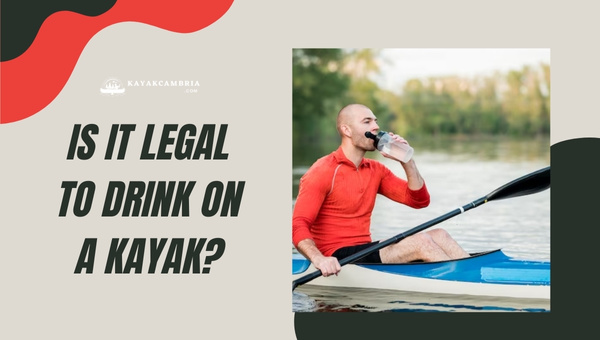
As a kayaker, it’s essential to be aware of the local boating laws in the area where you plan to kayak. In many jurisdictions, operating a vessel while under the influence of alcohol or drugs is against the law. This includes operating smaller watercraft such as kayaks, canoes, and paddleboards.
The Blood Alcohol Concentration (BAC) limit for operating a vessel can vary depending on the specific laws of a country, state, or region. For example, in the United States, the limit is generally 0.08%, similar to that for driving a motor vehicle on land. In Canada, the limit may be set at 0.05%.
Even though a kayak is not motorized, it is still considered a vessel, and you could be charged for Operating Under the Influence (OUI) or Boating Under the Influence (BUI) if you are found to be above the legal limit. The consequences of violating these laws can be severe, potentially leading to fines, loss of boating or driving privileges, and even imprisonment.
It’s crucial to be aware of the specific regulations and limits for your region to ensure safe legal compliance when you’re out kayaking. Checking with the local enforcement authorities or recreational boating associations in the area where you will be kayaking is an excellent way to stay informed.
Alcohol And Operating A Kayak
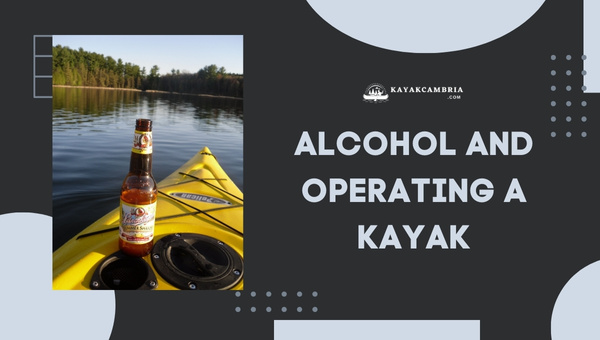
Alcohol consumption can have a significant impact on our physical and mental abilities, which could lead to disastrous consequences while kayaking. In this section, we’ll dive into the various effects of alcohol on our bodies and how they can hinder our ability to safely operate a kayak.
1. Balance And Coordination

One of the primary effects of alcohol is the impairment of balance and coordination. These skills are crucial when maneuvering a kayak, especially in rough waters or encountering unexpected obstacles. A tipsy kayaker is more likely to tip over, putting themselves and others at risk.
2. Decision-making And Judgment

Another concerning aspect of alcohol consumption is the impact it has on our decision-making abilities and judgment. Alcohol has a tendency to lower inhibitions which can lead to making poor choices, such as venturing into dangerous waters, underestimating risks, or overestimating our skills. These factors combined increase the likelihood of accidents occurring while out on the water.
3. Impaired Reaction Time
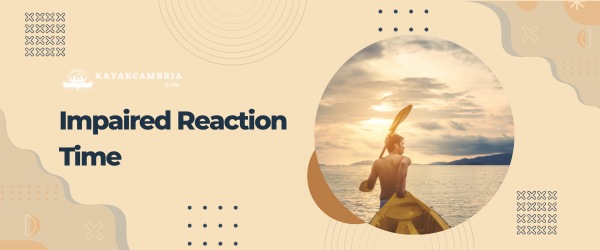
Alcohol consumption also slows down a person’s reaction time. This means that a kayaker under the influence may not be able to respond quickly enough to avoid hazards, such as floating debris, sudden changes in the water’s current, or another watercraft. In a situation that calls for split-second decision-making, any delay could prove disastrous.
4. Hypothermia Risks
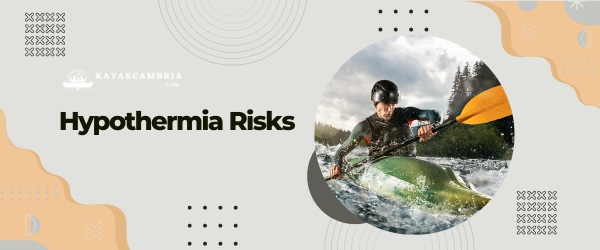
When exposed to cold water, the combination of alcohol and low body temperature increases the risk of hypothermia. Alcohol has the effect of dilating blood vessels, which causes a loss of heat from the body. If a kayaker ends up capsizing and spends a prolonged amount of time in cold water, this could have severe consequences on their well-being.
Alcohol consumption poses a substantial risk to kayakers by impairing their ability to maintain balance, coordinate movements, make sound decisions, and react quickly in unpredictable situations. It’s vital to establish a distinction between enjoying a drink after the kayaking trip and indulging while on the water. This way, we can ensure a safer and more enjoyable experience for everyone involved.
Personal Accountability While Kayaking With Alcohol
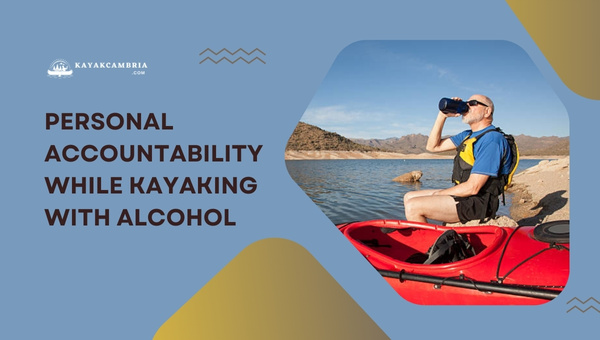
Taking personal responsibility for our actions is essential, especially when we are engaging in activities that pose potential risks. Wisely deciding whether or not to consume alcohol while kayaking requires not just considering our well-being but also the safety of others around us. Here are some key things to bear in mind when you find yourself weighing whether to drink on a kayak:
Assessing Your Alcohol Tolerance And Staying Within Limits

Knowing your personal limits and making conscious decisions to stay within those boundaries is crucial. If you choose to consume alcohol, ensure that you do so in moderation. This will help you maintain awareness and control over your actions while keeping your faculties intact.
Being Respectful Of Those Around You
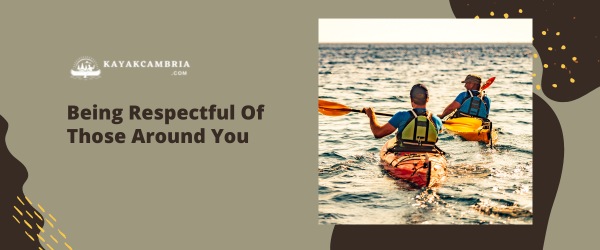
It’s important to bear in mind that other kayakers, boaters, and people in the water who may be impacted by your actions. As a responsible kayaker, it is your duty to minimize the potential risks for those around you as well as yourself.
Acknowledging The Potential Consequences

Remember that accidents can happen, even when you feel that you are being careful and responsible. Understanding the potential consequences of kayaking under the influence should remind you to prioritize safety over carefree indulgence.
Public safety announcement: Alcohol impairs judgment and decision-making abilities; don’t drink and paddle (Boating under the influence laws)
Taking personal accountability while kayaking with alcohol is all about making responsible decisions that prioritize your safety and that of the people around you. If you choose to indulge, doing so in moderation and with awareness of your limits and the potential consequences will help ensure an enjoyable and safe experience on the water.
Safe Alternatives To Drinking Alcohol On A Kayak
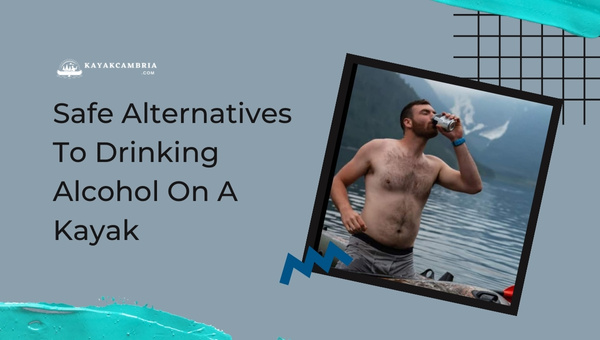
When planning a kayaking adventure, it’s natural to want fun and excitement, but it’s also important to keep safety as the top priority, particularly when it comes to alcohol consumption. Fortunately, there are several safe alternatives to drinking alcohol while on a kayak, allowing you to enjoy your time out on the water without compromising safety.
1. Hydration Options

Staying well-hydrated should be one of your main concerns while kayaking. Rather than reaching for alcohol, consider drinking water or electrolyte-enhanced beverages. These options will quench your thirst and help you avoid dehydration, which can severely hinder your kayaking performance.
2. Non-Alcoholic Beverages

If you’re craving the taste of a refreshing drink but don’t want the added risks of alcohol consumption, try non-alcoholic drinks such as mocktails or non-alcoholic beers. There are various recipes available for delicious non-alcoholic beverages that can be stored in a cooler and enjoyed on the go.
3. Designated Kayaker And Group Outings

Much like having a designated driver for a night out, having a designated kayaker in your group who abstains from alcohol can be a great way to ensure safety. This individual will remain sober to help oversee the group’s well-being and to effectively respond to any emergency situations that may arise.
Alternatively, you could also opt for group outings focused on kayaking, bonding with friends, and enjoying nature, leaving alcohol consumption for post-kayaking gatherings on land.
4. Dry-land Socializing

Another way to enjoy your kayaking trip without alcohol is to plan dry-land activities for after the paddling adventure. With this approach, you can spend your time on the water focusing on the sport, then later, once you are all safely back on shore, indulge in drinks and socializing.
There are plenty of ways to enjoy your time kayaking without alcohol. Prioritizing safety and remembering that alcohol can impair your judgment and coordination on the water is crucial.
Safety Tips When Kayaking With Or Without Alcohol
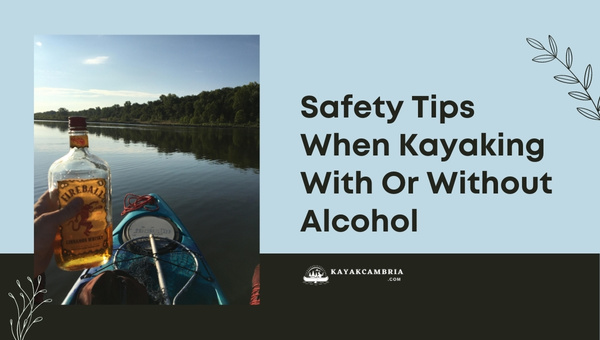
While kayaking it is important to understand that kayaking with alcohol can be dangerous. Here are some safety tips when kayaking with or without alcohol:
1. Wear A Life Jacket Or Personal Flotation Device (PFD)

Whether you choose to drink alcohol while kayaking or not, it’s essential that you always wear a properly fitted life jacket or personal flotation device (PFD). Accidents can happen to anyone, and a life jacket may be the difference between life and death in an emergency situation.
2. Never Kayak Alone Or Beyond Your Skill Level

Having a buddy system is crucial for kayaking. If you are planning to drink, make sure that at least one member of your group remains sober and alert. Also, be honest with your kayaking abilities and never attempt to navigate waters that are too challenging for your skill level – adding alcohol to the mix only makes it more dangerous.
3. Continuously Monitor Weather Conditions

Keep an eye on weather forecasts and watch for any sudden changes in the conditions. Poor visibility, strong winds, or sudden storms can lead to accidents, especially if you’ve been drinking.
4. Be Aware Of Other Waterway Users And Avoid Hazards
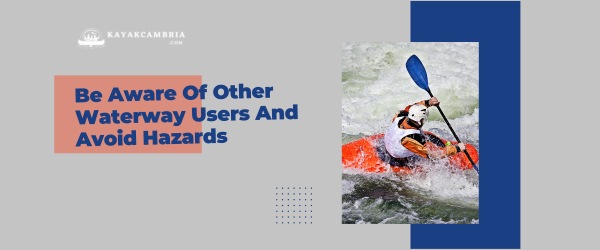
Whether you’re kayaking in a busy waterway or a secluded area, always be mindful of other users, such as swimmers, boats, and other kayakers. Stay clear of obstacles and potential hazards, like rocks, trees, or shallow water.
5. Check Your Kayak And Gear Before Heading Out Onto The Water
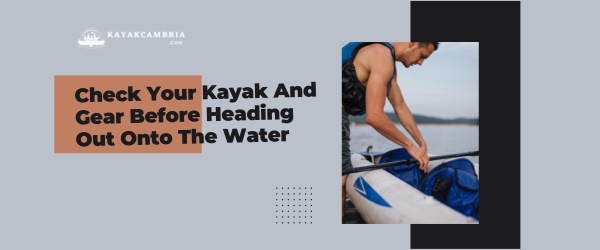
Ensure your kayak is in good condition and your gear is secured and fully functional before setting off. Regularly maintain both your kayak and equipment, and don’t forget to check for wear and tear. It’s best to avoid any issues that might arise while you’re out on the water, especially if you’ve consumed alcohol.
Can You Drink Beer While Kayaking in 2024?
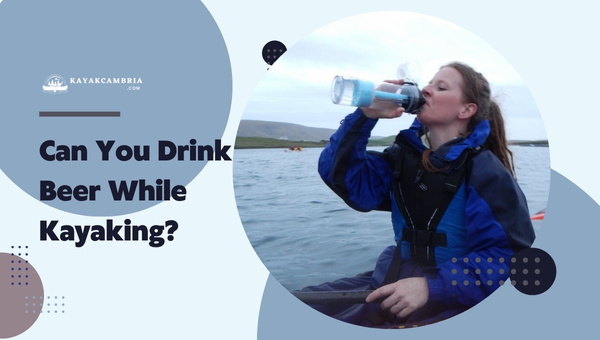
When it comes to enjoying a cold beer while kayaking, I find myself encountering mixed feelings. On one hand, the idea of sipping a refreshing brew as I paddle through picturesque landscapes can seem tempting. On the other, safety remains the top priority while kayaking. Let’s examine if it’s wise to indulge in beer on the water.
First and foremost, local boating laws must be taken into account. Drinking while operating a vessel can have legal repercussions, depending on the laws of your area. For instance, in some places open container laws may apply to kayaks, thus prohibiting open alcoholic beverages while kayaking. Do some research and ensure you understand the rules in place around your favorite kayaking spots to avoid any legal issues.
When it comes to actually consuming beer while kayaking, remember that alcohol can impair your balance, coordination, and decision-making skills—all of which are essential for kayaking. A loss of balance, even due to a small amount of alcohol, can lead to capsizing, putting both yourself and those around you at risk.
Additionally, kayaking often involves being in cold water or environments. Drinking beer in such conditions increases the risk of hypothermia, as alcohol dilates blood vessels and increases heat loss from the body.
To ensure personal accountability while kayaking with beer, take these points into consideration:
- Stay well within your limits and know how alcohol affects you
- Keep in mind the safety and welfare of others around you
- Remember that accidents can happen even when precautions are taken
Instead of sipping on a beer, opt for some safe alternatives that won’t hamper your kayaking experience. Hydrate yourself with water or electrolyte-rich beverages, and enjoy non-alcoholic drinks like tasty mocktails, or suave non-alcoholic beers. You can still enjoy the outdoors and socialize, without jeopardizing safety on the water.
Although some might argue that drinking a beer while kayaking is an acceptable risk, safety should always come first. It’s important to consider your own limits, respect the environment, and put both your safety and the well-being of others above the desire to have a cold brew on the water.
Different States Law And Penalties For Drinking While Kayaking in 2024?
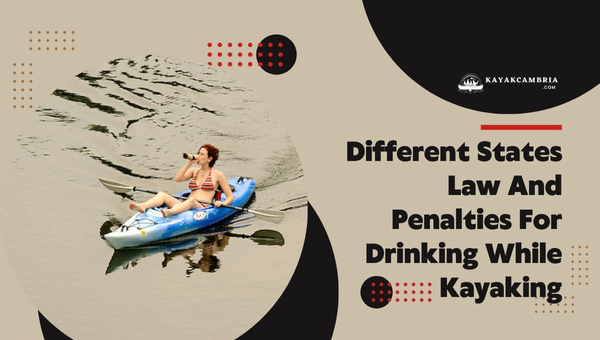
Understanding different states’ boating laws is essential before indulging in any drinking activity while kayaking. Remember that it’s up to you to be familiar with the rules and regulations of the area you’re in, as ignorance is not a valid excuse for breaking the law.
State-by-State Examples
California
In California, the Harbors and Navigation Code Section 655 prohibits operating a vessel under the influence of alcohol, drugs, or a combination of both. This includes kayaks. The legal blood alcohol content (BAC) limit is 0.08% for those over 21 and 0.01% for those under 21. Penalties can vary depending on prior offenses, but first-time convictions can result in fines up to $1,000 and/or six months in jail.
Florida
Florida considers it a criminal offense to operate a vessel while impaired by alcohol or drugs under the Florida Statute 327.35. Kayaks are also included under this law. The legal BAC limit is 0.08% for adults and 0.02% for minors (under 21 years). Penalties range from fines, community service, and probation to mandatory boating safety courses and jail time.
Texas
The Texas Penal Code 49.06 outlines the consequences of boating while intoxicated, which applies to anyone operating a watercraft, including kayakers. The legal BAC limit is the same as in other states, 0.08% for adults and 0.02% for those under 21. Texas law enforcement officers can swiftly suspend your boating privileges if you refuse a BAC test. Consequences include fines, confinement in jail, and suspension of the boat operator’s license.
For an exhaustive list of state laws and penalties for drinking while kayaking, check out the National Association of State Boating Law Administrators’ website here.
Consequences Beyond Fines And Legal Penalties
The monetary fines and penalties associated with drinking while kayaking can be severe, but the most significant consequences are the risks to personal safety and the safety of others on the water. Operating a kayak while intoxicated can lead to accidents, injuries, and even fatalities—a heavy burden to carry for the rest of your life.
To ensure a safe and enjoyable experience while kayaking, always prioritize practicing responsible drinking and following the local boating laws and regulations.
Frequently Asked Questions
1. Can I Have an Open Container of Alcohol on My Kayak?
Absolutely not. Just like with any other vehicle, it is forbidden to have an open container of alcohol on your kayak. Keep your beverages well-sealed and stored safely to avoid fines or unwanted encounters with law enforcement.
2. Can I Drink at the Shore and Then Go Kayaking?
While it might seem like a reasonable compromise, mixing drinking and kayaking still has its hazards. Alcohol can stay in your system for a while, impairing your balance, decision-making, and awareness. It’s best to wait until the effects of alcohol have subsided completely before heading out on the water.
3. Can I Be Charged with a DUI for Drinking on a Kayak?
Yes! In many places, drinking on a kayak can lead to a boating under the influence (BUI) charge, which has similar consequences to a DUI or DWI. Playing it safe by not drinking while kayaking can save you from fines, license suspensions, or even incarceration.
4. Are there Non-Alcoholic Drinks I can Enjoy While Kayaking?
Of course! Feel free to take along some refreshing non-alcoholic options like flavored water, iced tea, or mocktails. Remember that proper hydration is essential for a safe and enjoyable kayaking experience.
5. Can I Bring Alcohol for a Picnic or Break Onshore?
Should you feel inclined to partake in an onshore break, you can bring alcohol for a small picnic or get-together with friends, provided it is allowed in that area. It’s crucial, however, to ensure you are sober before getting back on your kayak, and always clean up any trash or bottles to maintain the beauty and integrity of the environment.
Conclusion
Drinking on a kayak is a topic that garners mixed opinions. While it is essential to consider the legal aspects, it is also crucial to prioritize safety, personal responsibility, and good judgement above all else. Regardless of your choice to consume alcohol or not, always be conscious of how your actions affect not only yourself but also those around you.
By following safety guidelines such as wearing life jackets, monitoring weather conditions, and staying within your skill level, you can enjoy a thrilling and satisfying kayaking experience. Moreover, choosing safe alternatives, like hydrating with water or enjoying a non-alcoholic drink, may contribute positively to your overall well-being.
In the end, the decision to drink on a kayak comes down to each individual’s sensibilities. Whatever you choose, always remember that maintaining a responsible and conscientious attitude is key to a memorable and incident-free kayaking adventure.

